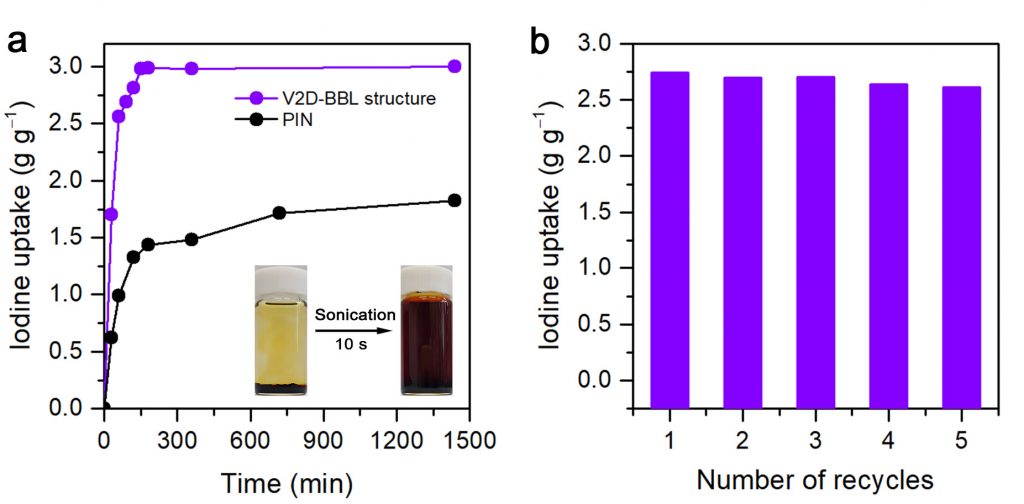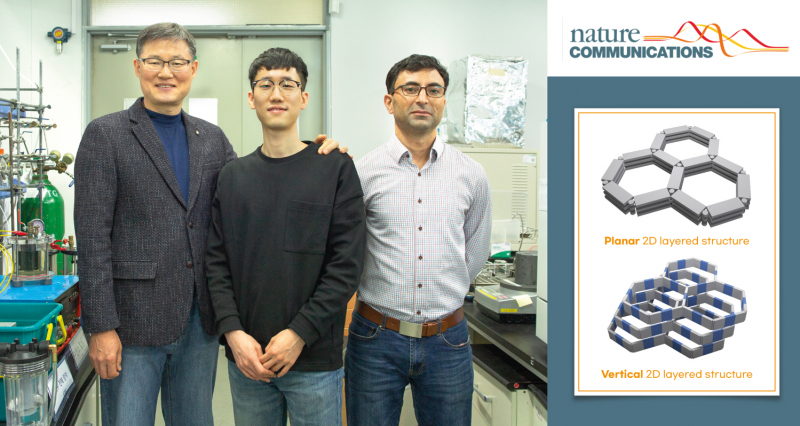A research team, led by Professor Jong-Beom Baek in the School of Energy and Chemical Engineering at UNIST has designed and synthesized a vertical two-dimensional (2D) layered structure to develop materials that exhibit excellent performance in terms of gas storage and for the removal of toxic substances. This is a vertically standing structural unit, which attributes to minimizing interlayer contact points and maximizing available exposed surface area.
Many attempts have been made to utilize planar 2D layered materials, such as graphene, for gas storage or the uptake of dangerous chemicals. This was due to their unique properties, particularly with regard to having holes that allow air to pass through and being simpler in design than 3D materials.
However, the stacking of 2D materials on top of each other creates chemical bonds between the layers, which ultimately causes the interlayer spacing becomes narrower. Due to layer-to-layer confinement, their segmental motion is very restricted, which affects their sorption/desorption kinetics when used as sorbent materials.

Figure 1: Synthesis of the vertical 2D layered structure.
To solve this issue, Professor Baek and his research team realized a vertical 2D layered BBL (designated V2D-BBL) structure via a simple wet chemical reaction in gram-scale. The prepared V2D-BBL structure exhibited outstanding physiochemical and thermal stability, and rigidity due to the fully fused aromatic ring system. Furthermore, its unique vertical 2D layered structure restricts interlayer π-π interaction, enabling maximum surface exposure while providing segmental freedom.
Besides, the structure exhibited superior thermoxidative stability even at high temperatures up to 600℃. “The V2D-BBL structure is composed of a nitrogen and oxygen doped fully fused aromatic ring system, which contributes to outstanding physiochemical and thermal stability, and rigidity due to the fully fused aromatic ring system,” says Hyuk-Jun Noh (Combined M.S/Ph.D. of Energy and Chemical Engineering, UNIST), first author of the study. “Thus, it is expected to be used in various high-temperature applications.”

Figure 2: Vapor iodine sorption study of the V2D-BBL structure.
The team confirmed that the V2D-BBL structure with uniform heteroatoms (N or O) and robust fused aromatic rings exhibited excellent gas uptake performance under both low and high pressures, and a high iodine (I2) uptake capacity with the fastest kinetics among reported organic porous materials to date.
“Since the discovery of graphene, the study of 2D materials and their structure properties have been extensively studied,” says Professor Baek. “This unique V2D-BBL structure can be a promising platform for high performance sorbent materials for practical applications.” He adds, “The development of the V2D-BBL structure underscores the huge potential for the design and synthesis of more unique structures in future.”
The findings of this research have been published in Nature Communications on April 24, 2020. This study has been supported by the Creative Research Initiative via the Ministry of Science and ICT (MSIT), Science Research Center (SRC), and Young Researcher programs through the National Research Foundation (NRF) of Korea.
Journal Reference
Hyuk-Jun Noh, Yoon-Kwang Im, Soo-Young Yu, et al., “Vertical two-dimensional layered fused aromatic ladder structure,” Nat. Commun., (2020).














